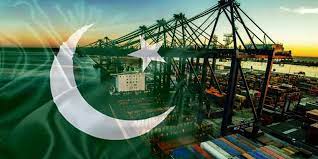Salman Raza
Pakistan has struggled with export-oriented industrial development during the last two decades. The rising trade deficit, which peaked at a value of around 48 billion USD in 2021-2022 and then about 27 billion USD in 2022-2023, increased a set of problems during to Forex crunch. Efforts in this regard are underway, with plans to scale Pakistan exports up to 100 billion USD in 5 years. Export-oriented industrial development is crucial to alleviating the burden of debt, averting economic downturns, and setting the country on the path to growth and development.
Pakistan uses Strategic Trade Policy Frameworks to target export growth and development of export-oriented industries in Pakistan historically. Most of the proposed plans had clear directions toward developing export-oriented initiatives and focused exports from the country but needed a clear path toward imports.
While we always had export-oriented strategies, we needed import strategies to boost our productive capacities and give much-needed stability vital for industrial development in a country. All the success stories of export-oriented growth ranging from Japan to China have achieved success not only through export orientation but also the result of export-oriented industries through developing the right kind of industries. While Pakistan has always had some of the best plans to achieve export-oriented growth, our trade deficit has swelled from 3.28 billion USD in 2003-2004 to 48.35 billion USD in 2022-2023.
Numerous factors are behind such a situation, but one ignored factor is a plan for importation. According to the father of the global value chain, Gary Gereffi, import substitution policies, and export-oriented industrial development have played a key role in China and East Asia’s economic success compared to South American countries. While Pakistan has a clear plan for export development, it lacks an import plan. An Analysis of Pakistan’s imports during 2021 using product classification available at World Integrated Trade Solutions (WITS) and UNCTAD indicated that Pakistan imported 33% consumer goods, 29% intermediate goods, 18% capital goods, and 20% raw materials. Unlike Pakistan, Vietnam imported only 14% of consumer goods, Bangladesh 23% and India only 12%.
This comparison indicates that Pakistan is becoming a consumer economy without going through the export-oriented industrialization phase. The right mix of imports defines the growth of local industries through the production of consumer goods at home. Even during the worst economic crisis during the early years of Deng Shao Peng in China and Vietnam and post-Vietnam War import policies, she played a vital role in export-oriented industrial development. Keeping the right import policies not only cuts down business costs but also enables industrial development, ensuring employment for local people. Pakistan completed its much-needed tariff policy in 2019.
The policy has introduced cascading tariff regimes, one step towards Pakistan’s export-oriented industrialization. However, the average tariff of raw materials is still 8.5%, while inclusive of all the withholding taxes, sales taxes, and additional customs duty, the average goes up to 39.5%. Such high tariff and tax structures increase the cost of doing business in Pakistan and kill productivity cycles through local investments.
These asymmetric structures are a hurdle for export-oriented industrial development in Pakistan while facilitating an import-oriented business environment away from productive manufacturing or entrepreneurship. Such arrangements destroy the level playing field for Pakistani exporters. Opening up new markets along with export incentives plays a vital role in boosting exports, but ensuring economic productivity by providing an enabling environment for business development is another fundamental.
One important lesson here is from the agricultural sector. Pakistan has become a net importer of food and agriculture products. Only 40.6% of the seeds provided in Pakistan are certified, and our current supply of seeds only caters to 40% of the demand. Different from regional neighbors, there is stagnation in crop productivity, marginal growth, or decline. Even in this situation where Pakistan depends on importing crops like Wheat, pulses, and palm oil, importing hybrid seeds faces 33% duties and taxes. Similarly, fertilizers have an average duties and taxes of 30%, including additional customs duties and taxes.
Local crop production suffers at the hands of the higher duties and taxes. Revenues collected in terms of taxes and obligations compared to payments made in USD for purchasing important crops like Wheat strained Pakistan’s economy even under more pressure. National Tariff Policy 2019-2024 states that tariffs will be used as a trade policy tool and must be implemented to ensure sustainable export orientation. Similar to export enhancement plans, Pakistan also needs import plans as well.
This will create a sustainable cycle for business development and an ecosystem to attract investments in Pakistan rather than increase imports of consumer goods. While the importance of consumer goods makes a country lose its productivity if it does not industrialize well, the supply of raw materials helps it diversify its industrial sectors.







